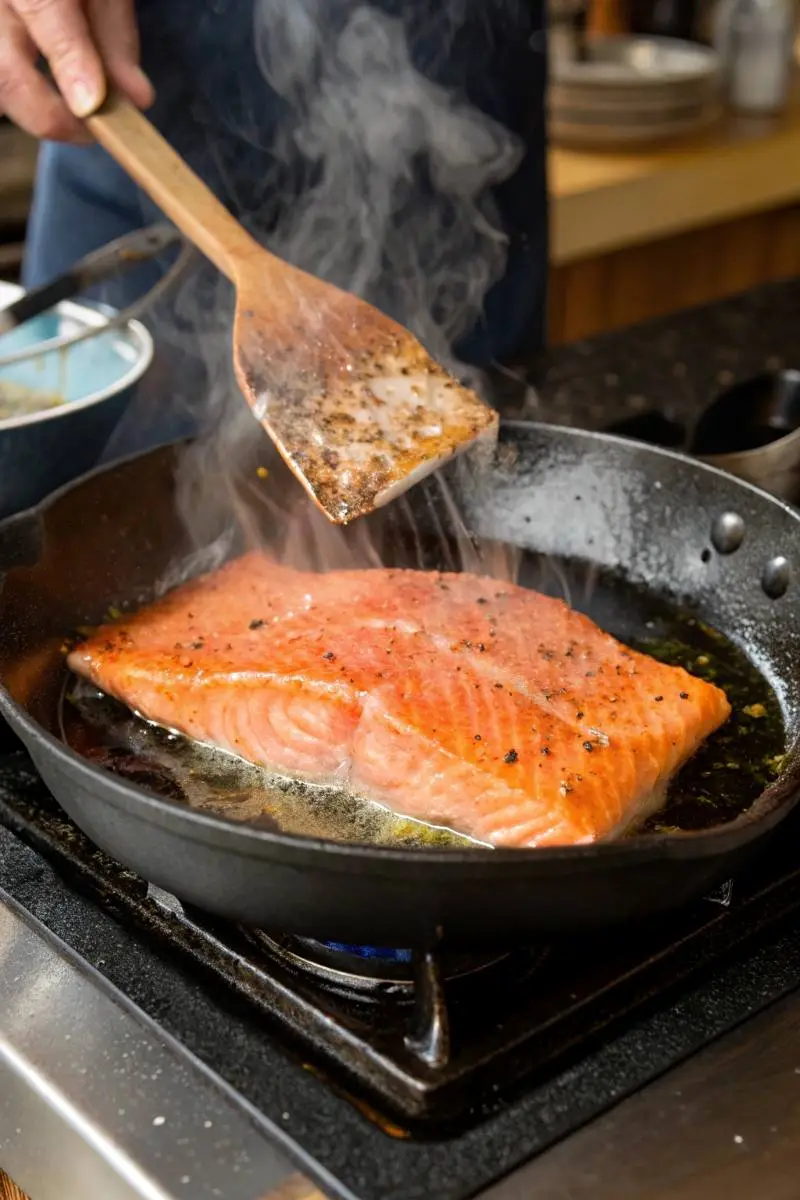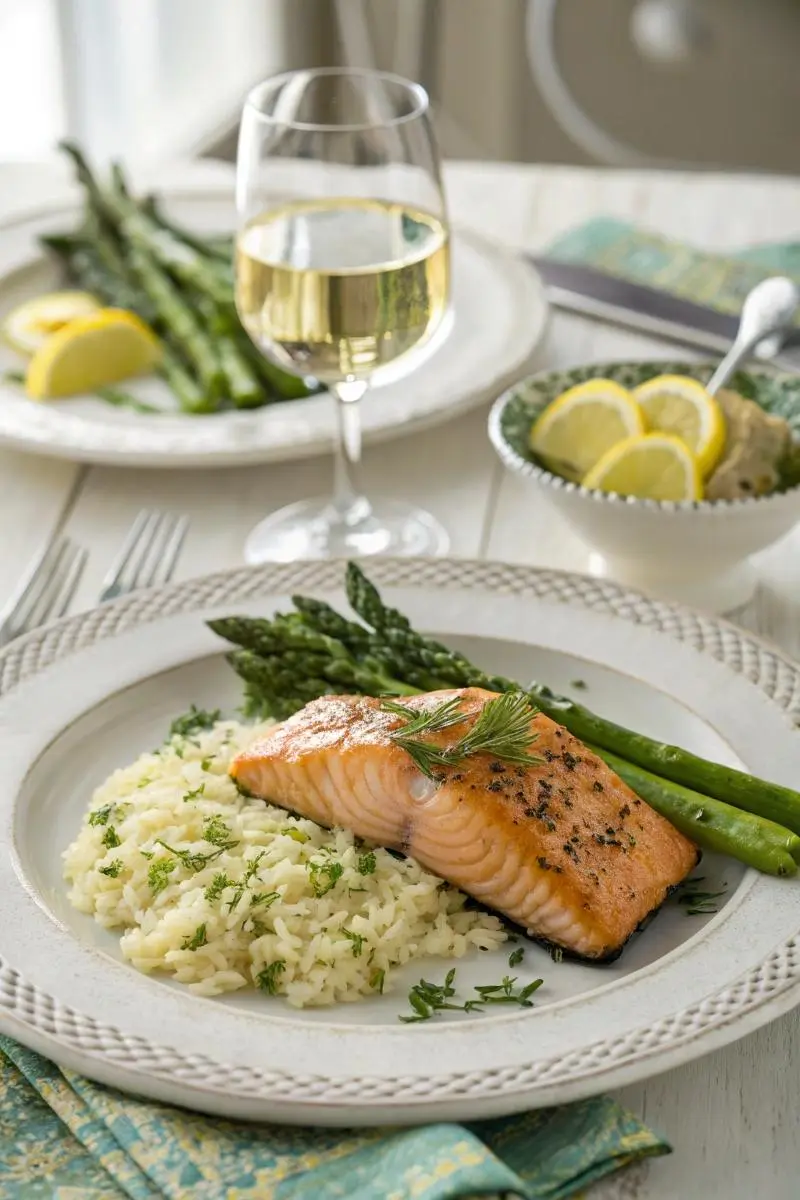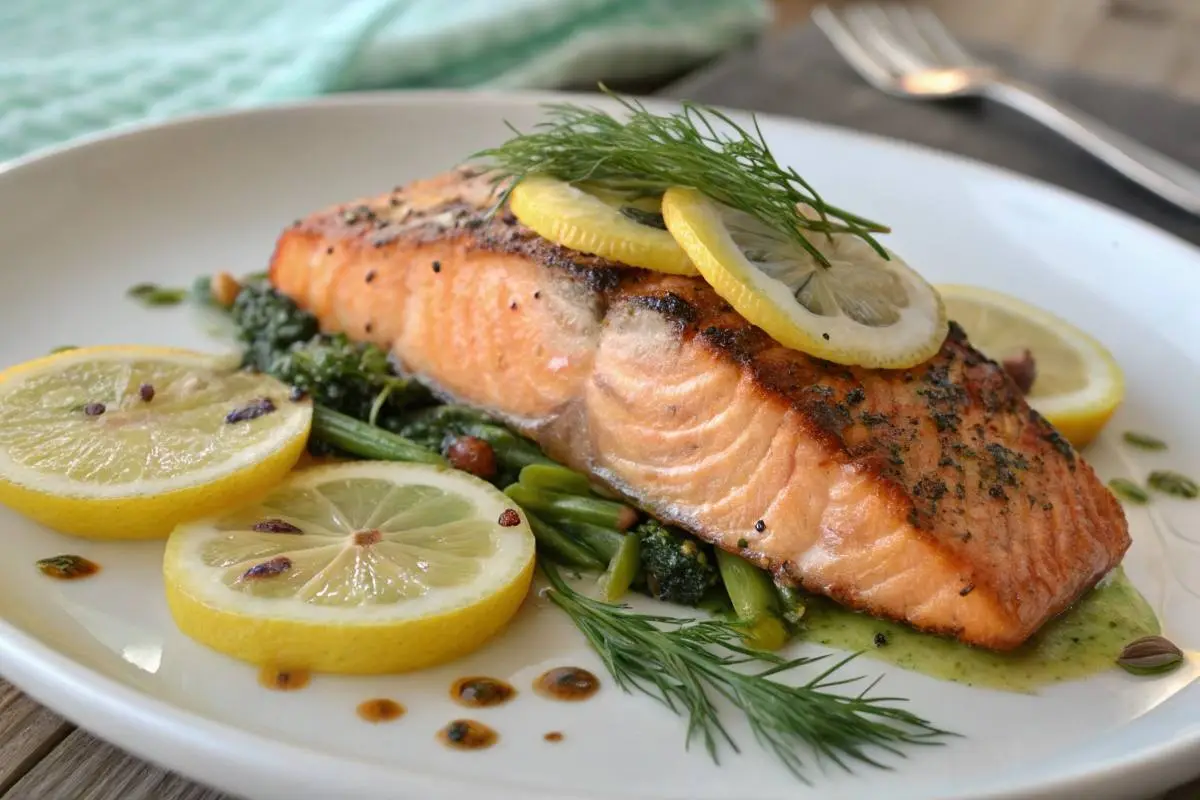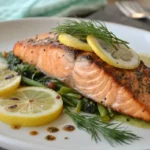Looking for a dish that screams elegance, flavor, and restaurant-quality results—all from your home kitchen? This king salmon recipe is your go-to solution. Rich, buttery, and tender, king salmon is the crown jewel of the sea. Known for its high-fat content and melt-in-your-mouth texture, it delivers a gourmet experience with simple ingredients and a straightforward cooking method.
Whether you’re a seafood enthusiast or just dipping your toes into home-cooked fish recipes, this guide walks you through everything you need to know about preparing king salmon like a pro. From choosing the proper cut to achieving that perfect golden sear, we’ve got you covered.
Don’t miss our Poor Man Husband Casserole: The Ultimate Comfort Dish on a Budget if you love hearty, easy meals with big payoffs.
Let’s dive into what makes king salmon so special—and why this recipe will become a regular on your dinner table.
Table of Contents
What Makes King Salmon So Special?
What Makes King Salmon So Special?
King salmon, also called Chinook salmon, is prized for its rich flavor, soft texture, and high omega-3 content. It’s the largest Pacific salmon species and is often considered the best-tasting salmon available. While it’s more expensive than other varieties, its superior flavor and health benefits make it a worthwhile splurge.
The deep orange color, buttery mouthfeel, and thick fillets set king salmon apart. It supports various cooking methods, making baking, grilling, pan-searing, or smoking ideal.
Why This Recipe Will Elevate Your Seafood Game
This king salmon recipe is designed for maximum flavor with minimal effort. By combining a few bold yet simple ingredients—like lemon, garlic, herbs, and high-quality olive oil—you can enhance the fish’s natural richness without overpowering it.
You’ll also learn:
- How to prevent overcooking
- Why resting your fish is as important as cooking it
- How to achieve that crispy-skin finish Gordon Ramsay would be proud of
Whether for a date night, a special celebration, or just a weeknight upgrade, this recipe will make your salmon the star of the plate.
What Is King Salmon?
Difference Between King Salmon and Other Salmon Types
King salmon (also known as Chinook salmon) is the most coveted variety of Pacific salmon. It’s distinguished by its higher fat content, rich flavor, and large size—often weighing over 20 pounds in the wild. Compared to other salmon types like sockeye, coho, or Atlantic salmon, king salmon offers:
| Type | Fat Content | Flavor | Color |
|---|---|---|---|
| King Salmon | Highest | Buttery, rich | Deep orange to red |
| Sockeye | Medium | Bold, slightly dry | Vivid red |
| Coho | Medium-low | Mild and firm | Light pink-orange |
| Atlantic Salmon | Farmed (usually) | Neutral, less rich | Pale pink |
In recipes that rely on moisture and flavor—like pan-seared fillets, baked fish, or smoked salmon—king salmon is unbeatable. It’s considered the gold standard by professional chefs and home cooks alike.
Why It’s Called the “King” of Salmon
The name isn’t just marketing—king salmon truly reigns supreme in taste, texture, and nutritional profile. Here’s why:
- It contains more omega-3 fatty acids per serving than any other salmon
- The fillets are thicker and meatier, making them ideal for grilling or baking
- It’s often caught wild from cold, clean waters in Alaska and the Pacific Northwest, giving it that unmistakably clean flavor
Discover great ideas like Lobster Roll: The Ultimate Guide to the East Coast’s Favorite Sandwich for more seafood favorites that elevate any menu.
Whether you’re making a weekday dinner or entertaining guests, king salmon’s natural richness means you don’t need complex seasonings to impress. A sprinkle of sea salt and a squeeze of lemon juice might be all you need.
Ingredients You Need for the Best King Salmon Recipe
Fresh vs. Frozen King Salmon: What to Choose?
When it comes to cooking a high-quality king salmon recipe, ingredient quality makes all the difference. Fresh, wild-caught king salmon is the gold standard—firm, vibrant, and rich in natural oils. However, high-quality flash-frozen king salmon can also be an excellent option, especially if you’re not near coastal markets.

Here’s how to compare:
| Type | Pros | Cons |
|---|---|---|
| Fresh | Best texture & flavor | Limited availability, pricey |
| Flash-Frozen | Convenient, often wild-caught | Must thaw properly |
| Farm-Raised | More affordable | Lower in omega-3, less flavor |
If you go with frozen, be sure to thaw it overnight in the fridge—never microwave or soak it in water.
Essential Marinades, Herbs, and Spices
While king salmon doesn’t need much to shine, the right seasonings can elevate the experience. Here’s a breakdown of essential flavor components for the perfect balance:
✅ Basic Ingredient List:
- 2 king salmon fillets (about 6 oz each, skin-on)
- 1 tablespoon olive oil
- 1 tablespoon unsalted butter
- 2 cloves garlic, minced
- Zest and juice of 1 lemon
- 1 teaspoon fresh thyme or dill
- Salt and freshly cracked black pepper
Optional Add-ons:
- A drizzle of honey or maple syrup for a sweet finish
- A dash of smoked paprika or chili flakes for heat
- A spoonful of Dijon mustard in the marinade for tang
Simple marinades work best. For example:
Marinade: 1 tbsp olive oil + 1 tsp lemon zest + pinch of garlic + salt & pepper.
Let the salmon sit in your marinade for 10–15 minutes max—any longer and the acidity (from lemon or vinegar) could start to “cook” the fish.
Check out Raspberry Swirl Cookies: The Best Tart and Sweet Cookie Treat You’ll Ever Bake for a dessert pairing that finishes your salmon dinner with a sweet, bakery-style bite.
How to Cook King Salmon (Step-by-Step)
Pan-Seared King Salmon
If you’re aiming for crispy skin and a buttery interior, pan-searing is the go-to method. It’s quick, elegant, and perfect for showcasing the natural flavor of king salmon.

🔥 Step-by-Step Instructions:
- Pat the fillets dry with a paper towel (moisture = steam = no crisp).
- Season both sides with salt and pepper. Add lemon zest or garlic powder if desired.
- Heat 1 tablespoon olive oil in a nonstick or cast-iron skillet over medium-high heat.
- Place the salmon skin-side down and press lightly for 10 seconds to prevent curling.
- Cook without moving for 5–6 minutes, until the skin is golden and crispy.
- Flip carefully and add a pat of butter and minced garlic to the pan.
- Baste with the melted butter for 1–2 minutes, until the top is just cooked through.
- Remove from heat, squeeze with lemon juice, and rest for 2 minutes before serving.
🍳 Pro Tip: Don’t overcrowd the pan. Cook in batches if needed for even searing.
Oven-Baked or Broiled King Salmon
Prefer a hands-off approach? Oven-baking or broiling offers consistent results with very little cleanup.
🔥 How to Bake It:
- Preheat oven to 400°F (205°C).
- Place salmon on a foil-lined baking sheet.
- Brush with olive oil, sprinkle with lemon zest, garlic, and herbs.
- Bake for 12–15 minutes, depending on thickness. Center should flake with a fork.
- Optional: Broil for the last 1–2 minutes to crisp the top.
💡 Internal temperature should reach 125–130°F for medium and buttery texture.
Quick Comparison:
| Method | Texture | Time | Best For |
|---|---|---|---|
| Pan-seared | Crispy outside, juicy inside | 8–10 min | Fast dinners, crispy skin |
| Oven-baked | Tender and moist | 15–20 min | Family meals, meal prep |
| Broiled | Slightly charred top | 10–12 min | Restaurant-style presentation |
Discover great ideas like Lobster Roll: The Ultimate Guide to the East Coast’s Favorite Sandwich for more seafood recipes that deliver bold, satisfying flavors.
Pro Tips to Cook King Salmon Perfectly Every Time
Avoiding Overcooking: Temperature and Timing
King salmon is a luxurious fish—don’t ruin it with overcooking. Because of its higher fat content, king salmon stays moist longer than leaner varieties, but timing still matters.
🔥 Internal Temperature Guidelines:
| Doneness | Internal Temp | Texture |
|---|---|---|
| Medium-Rare | 120–125°F | Silky, tender, moist |
| Medium | 125–130°F | Buttery, slightly firm |
| Well Done | 135°F+ | Dry, flaky, less flavor |
✅ Use an instant-read thermometer and remove the salmon when it’s 5°F below your target—carryover heat will finish it as it rests.
Skin-On vs. Skin-Off: Which Method Works Best?
The skin of king salmon serves a purpose beyond aesthetics:
- Acts as a protective barrier against overcooking
- Helps retain moisture and structure
- Becomes crispy and delicious when pan-seared
If you’re baking or poaching the fish, skin-off is fine. But for pan-searing or grilling, keep the skin on and crisp it properly for flavor and texture.
Extra Pro Tips for Perfection
- Always bring salmon to room temperature for 10–15 minutes before cooking—it cooks more evenly.
- Use neutral oils with a high smoke point (like avocado or grapeseed oil) for searing.
- Don’t overcrowd the pan—let the fish breathe for even browning.
- Let it rest for 2–3 minutes after cooking before serving. This allows the juices to redistribute.
Looking for inspiration? Try Raspberry Swirl Cookies: The Best Tart and Sweet Cookie Treat You’ll Ever Bake to follow your rich fish dinner with a vibrant, refreshing dessert.
King Salmon Recipe Variations You’ll Love
Grilled King Salmon with Lemon Butter
Want that irresistible smoky flavor with a caramelized crust? Grilled king salmon brings out the natural richness of the fish while adding charred complexity.
🔥 How to Make It:
- Preheat grill to medium-high and oil the grates well.
- Brush salmon fillets with olive oil, lemon juice, salt, and pepper.
- Grill skin-side down for 5–6 minutes.
- Flip gently and grill another 2–3 minutes.
- Finish with a drizzle of lemon-garlic butter right before serving.
The lemon butter not only enhances the flavor, but the fat also helps prevent sticking.
Asian-Inspired King Salmon Teriyaki Bowl
This variation turns your salmon into a restaurant-style bowl meal with umami-packed flavors.
🍱 Quick Teriyaki Glaze:
- 2 tbsp soy sauce
- 1 tbsp honey or brown sugar
- 1 tsp grated ginger
- 1 clove garlic, minced
- 1 tsp sesame oil
- Optional: splash of rice vinegar or mirin
Simmer until thickened, then brush over seared or baked salmon. Serve over jasmine rice with steamed broccoli, edamame, or pickled vegetables.
🍽️ Top with sesame seeds and green onions for that perfect Instagram-worthy touch.
More Variation Ideas:
| Variation | Flavor Profile | Serve With |
|---|---|---|
| Blackened Cajun King Salmon | Spicy and smoky | Dirty rice, corn on the cob |
| Honey Mustard Glazed Salmon | Sweet-tangy | Roasted carrots, green beans |
| Mediterranean Baked Salmon | Herby, bright, olive oil–based | Quinoa salad, tzatziki |
Looking for inspiration? Try Poor Man Husband Casserole: The Ultimate Comfort Dish on a Budget for more comfort-food meals you can adapt and customize endlessly.
What to Serve with King Salmon
Best Side Dishes for a Balanced Plate
King salmon is rich and flavorful on its own, so pairing it with fresh, bright, or mildly starchy sides helps balance the meal. Here are some delicious ideas that enhance your king salmon recipe without overpowering it:
🥗 1. Roasted Vegetables
Try asparagus, Brussels sprouts, or rainbow carrots tossed with olive oil, garlic, and sea salt. Roast at 425°F for 20 minutes until tender and slightly charred.
🍚 2. Lemon Herb Rice Pilaf
Light and fluffy rice with fresh herbs (parsley, dill) and lemon zest complements the buttery flavor of salmon perfectly.
🥬 3. Cucumber-Dill Salad
Cool, crunchy, and tangy—this side offers a refreshing contrast. Mix sliced cucumber with Greek yogurt, lemon juice, and fresh dill.
🥔 4. Garlic Mashed Potatoes
Creamy, comforting, and simple. A perfect contrast to the richness of the fish, especially for colder seasons or dinner parties.

| Side Dish | Texture/Flavor | Why It Works |
|---|---|---|
| Roasted Asparagus | Crispy, savory | Adds crunch and brightness |
| Rice Pilaf with Lemon | Fluffy, citrusy | Soaks up the salmon’s natural juices |
| Dill Cucumber Salad | Cool, tangy, hydrating | Balances rich fish with freshness |
| Mashed Potatoes | Creamy, earthy | Comforting, classic pairing |
Ideal Sauces and Garnishes to Complement the Fish
Simple sauces can go a long way in enhancing your salmon dish:
- Lemon-dill yogurt sauce – Light and tangy, great with grilled or baked salmon.
- Honey-mustard glaze – Sweet and zesty, perfect as a finishing drizzle.
- Chimichurri or herb salsa verde – For a bold, herby punch.
- Classic beurre blanc – If you’re going full French fine dining.
✅ Garnish with lemon slices, chopped parsley, or microgreens for a restaurant-style touch.
End on a sweet note with Raspberry Swirl Cookies: The Best Tart and Sweet Cookie Treat You’ll Ever Bake—a perfect dessert pairing for a salmon-centered dinner.
How to Store and Reheat Leftover King Salmon
How to Store King Salmon in the Fridge or Freezer
Leftover king salmon keeps well when stored properly. While best eaten fresh, it can still shine the next day if handled with care.
🧊 In the Fridge:
- Cool salmon completely before storing.
- Wrap it tightly in foil or place in an airtight container.
- Store in the coldest part of your fridge, ideally no more than 2 days.
❄️ In the Freezer:
- Wrap individual portions in parchment paper + foil, or use a vacuum sealer.
- Place in a freezer-safe zip bag, label with date.
- Freeze for up to 2 months for best texture.
Tip: Always thaw frozen salmon overnight in the fridge before reheating—never microwave from frozen, as it’ll dry out and lose its flavor.
Best Ways to Reheat Without Drying It Out
Reheating salmon can be tricky—you want it warm, not overcooked. Here’s how to do it right:
🔥 Oven (Best Method)
- Preheat oven to 275°F (135°C).
- Place salmon on a baking sheet, loosely covered with foil.
- Add a splash of broth or lemon juice to keep it moist.
- Reheat for 10–15 minutes or until just warmed through.
🍳 Stovetop (Quick)
- Use a non-stick pan with a bit of olive oil or butter.
- Heat gently on medium-low, covered, for 3–5 minutes.
- Avoid flipping to keep it from breaking apart.
❌ What to Avoid:
- Microwaving on high (dries out the fish)
- Reheating more than once (kills flavor and texture)
- Leaving leftovers in the fridge longer than 2 days
Bonus: Flake your leftover king salmon into salads, pasta, or breakfast omelets to reinvent the meal.
Learn more about smart storage in our Poor Man Husband Casserole: The Ultimate Comfort Dish on a Budget—great for batch-cooking and leftovers.
Frequently Asked Questions (FAQ)
How to cook king salmon Gordon Ramsay style?
ordon Ramsay’s king salmon technique focuses on pan-searing over medium-high heat with simple seasoning—usually sea salt, cracked pepper, and a touch of lemon zest. He recommends:
– Using a hot non-stick or cast-iron pan
– Starting skin-side down and pressing the fillet gently
– Basting the salmon in butter, garlic, and herbs after flipping
– Resting the fillet 2–3 minutes before plating
The result is restaurant-quality salmon with a crispy skin and tender interior.
What is the best cooking method for king salmon?
The best method depends on your taste—but for maximum flavor and texture, many chefs swear by pan-searing with the skin on. This method delivers a crispy crust and buttery center. Baking or grilling also works wonderfully if you prefer a hands-off, no-mess approach.
Tip: Always aim for an internal temperature of 125°F (medium) to keep it moist and flavorful.
What is the tastiest way to cook salmon?
While taste is subjective, many agree that searing or grilling king salmon brings out the richest, boldest flavors. Especially when paired with:
– Lemon butter sauce
– Teriyaki glaze
– Herb-infused olive oil
Cooking it skin-on with a quick finish under the broiler adds that irresistible caramelized edge.
Is king salmon different from salmon?
Yes—king salmon (Chinook) is a specific species and considered the most premium of all salmon types. It differs in several ways:
– Higher fat content
– Richer, buttery flavor
– Thicker, meatier fillets
– Usually wild-caught from Alaska or the Pacific Northwest
In contrast, Atlantic salmon is often farmed and has a milder taste and softer texture.
Why is king salmon so expensive?
King salmon is rarer and harder to catch than other salmon varieties. It’s usually:
– Wild-caught in limited numbers
– Larger in size, with more meat per fish
– High in omega-3 fatty acids, making it both healthy and luxurious
Environmental sustainability also plays a role—fisheries have quotas, and demand often exceeds supply.
Is king salmon healthy to eat ?
Yes, it’s one of the healthiest fish you can eat. It’s loaded with:
– Omega-3 fatty acids (supports heart, brain, and joints)
– High-quality protein
– Vitamin D and B12
Low in mercury compared to larger fish like tuna
It’s especially great for people following Mediterranean or anti-inflammatory diets.
Is king salmon healthy to eat ?
Yes, it’s one of the healthiest fish you can eat. It’s loaded with:
– Omega-3 fatty acids (supports heart, brain, and joints)
– High-quality protein
– Vitamin D and B12
Low in mercury compared to larger fish like tuna
It’s especially great for people following Mediterranean or anti-inflammatory diets.
Learn more about Lobster Roll: The Ultimate Guide to the East Coast’s Favorite Sandwich to discover another premium seafood option that’s worth every bite.
PrintKing Salmon Recipe – The Most Flavorful Way to Cook Premium Fish
A buttery, rich king salmon recipe featuring crisp skin, juicy flesh, and simple, bold ingredients. Learn how to pan-sear, bake, or grill it like a pro with tips, variations, and perfect pairings.
- Prep Time: 10 minutes
- Cook Time: 10 minutes
- Total Time: 20 minutes
- Yield: 2 servings 1x
- Category: Dinner
- Cuisine: American
Ingredients
2 fresh king salmon fillets (6 oz each, skin-on)
1 tablespoon olive oil
1 tablespoon unsalted butter
2 cloves garlic, minced
Zest and juice of 1 lemon
1 teaspoon fresh thyme or dill
Salt and freshly cracked black pepper, to taste
Optional:
1 teaspoon Dijon mustard (for marinade)
1 teaspoon honey or maple syrup (for glaze)
Pinch of red pepper flakes or smoked paprika
Instructions
- Pat the salmon fillets dry with paper towels and let them rest at room temperature for 10–15 minutes.
- Season both sides with salt, pepper, lemon zest, and optional Dijon or honey glaze.
- In a non-stick or cast-iron skillet, heat olive oil over medium-high heat until shimmering.
- Place salmon skin-side down, pressing gently for the first 10 seconds to keep it flat.
- Cook undisturbed for 5–6 minutes until the skin is golden and crispy.
- Flip the fillets carefully, add butter and garlic to the pan, and baste the fish for 1–2 minutes.
- Remove from heat, squeeze fresh lemon juice over the top, and let rest for 2–3 minutes before serving.
Notes
- To grill: Brush salmon with olive oil and grill skin-side down for 5–6 minutes. Flip and cook for 2 more minutes.
- To bake: Preheat oven to 400°F. Bake salmon for 12–15 minutes with a drizzle of lemon-butter sauce.
- Pair with rice pilaf, roasted asparagus, or cucumber-dill salad for a full meal.
- Do not over-marinate — acidic ingredients like lemon can “cook” the fish if left too long.
Nutrition
- Serving Size: 1 fillet (6 oz)
- Calories: 480 kcal
- Sugar: 0g
- Sodium: 150mg
- Fat: 26g
- Saturated Fat: 6g
- Unsaturated Fat: 17g
- Trans Fat: 0g
- Carbohydrates: 3g
- Fiber: 0g
- Protein: 34g
- Cholesterol: 95mg
Keywords: king salmon recipe, pan-seared salmon, crispy salmon skin, healthy salmon dinner
Conclusion
Cooking with king salmon is more than just preparing a meal—it’s an experience. From its melt-in-your-mouth texture to its rich, buttery flavor, King Salmon truly earns its royal name. With the proper technique, a few quality ingredients, and patience, you can turn this premium fish into a show-stopping centerpiece for any occasion.
Whether you’re searing it Gordon Ramsay–style, baking it in lemon butter, or grilling it to perfection, this king salmon recipe gives you the tools to create a dish that’s both elegant and easy. You’ve learned how to choose the best cut, cook it like a pro, and serve it with the perfect sides—plus how to store and reheat it without sacrificing flavor.
So the next time you want to impress someone—or treat yourself to something extraordinary—skip the takeout. This king salmon recipe is everything you need for a restaurant-quality meal at home.
End on a sweet note with Raspberry Swirl Cookies: The Best Tart and Sweet Cookie Treat You’ll Ever Bake—a perfect way to wrap up your seafood feast.


3 thoughts on “King Salmon Recipe – The Most Flavorful Way to Cook Premium Fish”